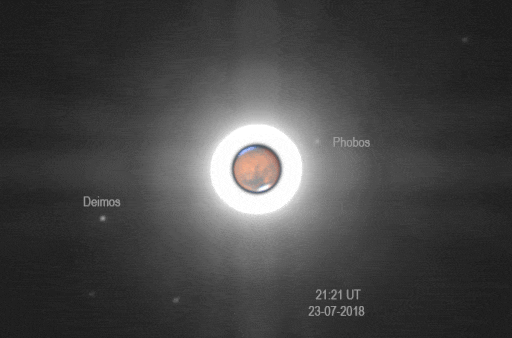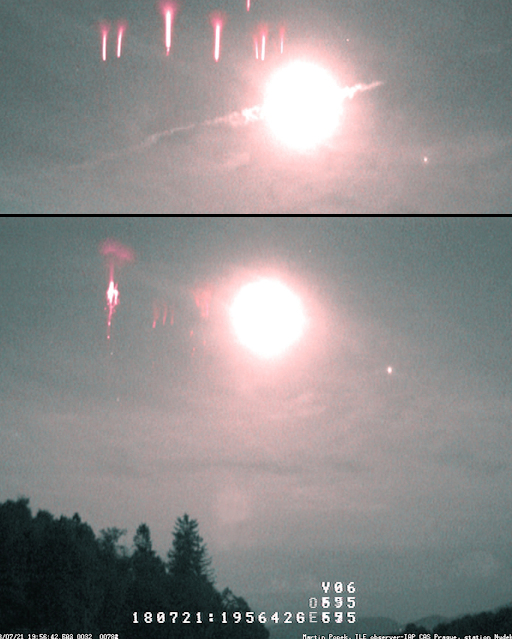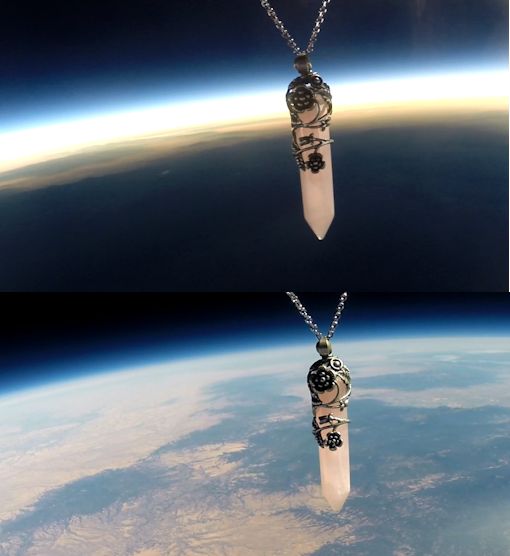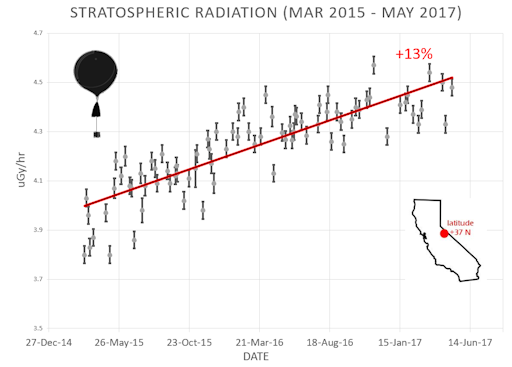 | | | Switch to: Europe, USA, New Zealand, Antarctica Credit: NOAA/Ovation  Planetary K-index Planetary K-index
Now: Kp= quiet
24-hr max: Kp= quiet
explanation | more data
Interplanetary Mag. Field
Btotal: 4.6 nT
Bz: -0.9 nT south
more data: ACE, DSCOVR
Updated: Today at 2346 UT  Coronal Holes: 26 Jul 18 Coronal Holes: 26 Jul 18 
Earth is inside a stream of solar wind flowing from the indicated coronal hole. Credit: SDO/AIA  Noctilucent Clouds The season for noctilucent clouds in he northern hemisphere is underway. Check here daily for the latest images from NASA's AIM spacecraft. Switch view: Europe, USA, Asia, Polar Updated at: 07-26-2018 19:55:03 Noctilucent Clouds The season for noctilucent clouds in he northern hemisphere is underway. Check here daily for the latest images from NASA's AIM spacecraft. Switch view: Europe, USA, Asia, Polar Updated at: 07-26-2018 19:55:03  SPACE WEATHER
NOAA Forecasts | | Updated at: 2018 Jul 26 2200 UTC FLARE | 0-24 hr | 24-48 hr | CLASS M | 01 % | 01 % | CLASS X | 01 % | 01 % |  Geomagnetic Storms: Geomagnetic Storms:
Probabilities for significant disturbances in Earth's magnetic field are given for three activity levels: active, minor storm, severe storm Updated at: 2018 Jul 26 2200 UTC Mid-latitudes | 0-24 hr | 24-48 hr | ACTIVE | 15 % | 15 % | MINOR | 05 % | 05 % | SEVERE | 01 % | 01 % | High latitudes | 0-24 hr | 24-48 hr | ACTIVE | 15 % | 15 % | MINOR | 20 % | 20 % | SEVERE | 20 % | 20 % | | | |  | | | | | | | | | | | All-inclusive Northern Lights trips in Tromsø, Norway. Small groups, big experiences! Highly qualified guides ensure unique and unforgettable adventures with a personal touch. Visit Explore the Arctic | | | LUNAR ECLIPSE AND MARTIAN CONJUNCTION: Friday, July 27th, is a big night for astronomy. Mars will be at opposition--directly opposite the sun and making a 15-year close approach to Earth. Also, Mars and the Moon will be in conjunction--less than 10 degrees apart. And best of all, the Moon will pass through the shadow of Earth, producing the longest lunar eclipse in a century--visible everywhere except North America. What a night! Tune into live webcasts from Israel and Belgium. FEAR AND PANIC: The two moons of Mars, Phobos and Deimos (Greek for Fear and Panic), are easy to overlook. They're tiny, less than 22 km wide, dim and rarely seen through a telescope. Mars itself shines 242,000 times brighter than Phobos and 741,000 times brighter than Deimos. The two moons get lost in the glare. But with Mars on the verge of a 15-year close approach to Earth, the tiny moons are possible to photograph. Dzmitry Kananovich of Crete did it on July 23rd: 
"During the current opposition of Mars, Phobos and Deimos are relatively easy targets," says Kananovich. "At least I captured them much easier than during my previous attempt in 2016. The animation demonstrates the orbital motion of Phobos and Deimos around the Red Planet. I used an 11-inch Celestron telescope to capture the images. Separately, I photographed Mars using R, G, B filters to get a non-overexposed color image, which was added afterwards." As Mars approaches Earth this week, many rare and beautiful pictures of the Red Planet will be taken. Monitor our realtime Mars photo gallery for the latest:
Realtime Mars Photo Gallery
SPRITES VS. THE MOON: Red sprites that leap up from thunderstorms are always brief and often dim. On July 21st they were bright enough to see through the glare of the waxing Moon. Martin Popek photographed the display from Nýdek in the Czech republic: 
Sprites are an exotic form of upward-directed lightning, reaching from the tops of electrical storms all the way up to the edge of space. Because they emerge from the tops of storms, the best place to see sprites is from a distance where the camera can point over the edge of the thunderhead.
"I was about 200 km away from the storm," says Popek. "It was a porwerful Mesoscale Convective System across the border in Hungary."
Some researchers think that sprites are linked to cosmic rays. Subatomic particles from deep space strike the top of Earth's atmosphere, producing secondary electrons that trigger the upward bolts. Cosmic rays are now intensifying due to the decline of the solar cycle. More sprites, anyone? Realtime Sprite Photo Gallery INSIDE THE SHADOW OF THE MOON: Last August, during the Great American Solar Eclipse, the students of Earth to Sky Calculus launched 11 space weather balloons from the path of totality. Their mission: to photograph the Moon's shadow from the stratosphere. These rose quartz crystals went along for the ride: 
During the 2.5 hour flight, the pendants were wrapped in the Moon's shadow for more than two minutes, experiencing a spooky darkness colder than -50 C. We still have a few left, and you can have one for $169.95. Each crystal pendant comes with a unique gift card showing the jewelry passing through the Moon's shadow and floating at the top of Earth's atmosphere. The interior of the card tells the story of the flight and confirms that this gift has been to the edge of space and back again. Far Out Gifts: Earth to Sky Store
All sales support hands-on STEM education
Realtime Noctilucent Cloud Photo Gallery
Realtime Aurora Photo Gallery
Realtime Space Weather Photo Gallery Every night, a network of NASA all-sky cameras scans the skies above the United States for meteoritic fireballs. Automated software maintained by NASA's Meteoroid Environment Office calculates their orbits, velocity, penetration depth in Earth's atmosphere and many other characteristics. Daily results are presented here on Spaceweather.com. On Jul. 26, 2018, the network reported 79 fireballs.
(70 sporadics, 3 Southern delta Aquariids, 3 alpha Capricornids, 1 psi Cassiopeid, 1 Perseid, 1)  In this diagram of the inner solar system, all of the fireball orbits intersect at a single point--Earth. The orbits are color-coded by velocity, from slow (red) to fast (blue). [Larger image] [movies] Potentially Hazardous Asteroids ( PHAs) are space rocks larger than approximately 100m that can come closer to Earth than 0.05 AU. None of the known PHAs is on a collision course with our planet, although astronomers are finding new ones all the time. On July 26, 2018 there were 1912 potentially hazardous asteroids.
 | Recent & Upcoming Earth-asteroid encounters: | Asteroid | Date(UT) | Miss Distance | Velocity (km/s) | Diameter (m) | | 2018 OY | 2018-Jul-21 | 6.2 LD | 10 | 31 | | 2018 NE1 | 2018-Jul-21 | 10.1 LD | 14.2 | 73 | | 2018 NF4 | 2018-Jul-21 | 18.8 LD | 12.8 | 114 | | 2018 OL | 2018-Jul-22 | 11.5 LD | 16.1 | 57 | | 2018 NR1 | 2018-Jul-27 | 17.1 LD | 5.1 | 35 | | 2018 OZ | 2018-Aug-06 | 7 LD | 9.6 | 34 | | 2018 LQ2 | 2018-Aug-27 | 9.4 LD | 1.5 | 39 | | 2016 GK135 | 2018-Aug-28 | 16.8 LD | 2.8 | 9 | | 2016 NF23 | 2018-Aug-29 | 13.3 LD | 9 | 93 | | 1998 SD9 | 2018-Aug-29 | 4.2 LD | 10.7 | 51 | | 2018 DE1 | 2018-Aug-30 | 15.2 LD | 6.5 | 28 | | 2001 RQ17 | 2018-Sep-02 | 19.3 LD | 8.3 | 107 | | 2015 FP118 | 2018-Sep-03 | 12.3 LD | 9.8 | 490 | | 2017 SL16 | 2018-Sep-20 | 8.5 LD | 6.4 | 25 | Notes: LD means "Lunar Distance." 1 LD = 384,401 km, the distance between Earth and the Moon. 1 LD also equals 0.00256 AU. MAG is the visual magnitude of the asteroid on the date of closest approach. | | Cosmic Rays in the Atmosphere |
Readers, thank you for your patience while we continue to develop this new section of Spaceweather.com. We've been working to streamline our data reduction, allowing us to post results from balloon flights much more rapidly, and we have developed a new data product, shown here: 
This plot displays radiation measurements not only in the stratosphere, but also at aviation altitudes. Dose rates are expessed as multiples of sea level. For instance, we see that boarding a plane that flies at 25,000 feet exposes passengers to dose rates ~10x higher than sea level. At 40,000 feet, the multiplier is closer to 50x. These measurements are made by our usual cosmic ray payload as it passes through aviation altitudes en route to the stratosphere over California. What is this all about? Approximately once a week, Spaceweather.com and the students of Earth to Sky Calculus fly space weather balloons to the stratosphere over California. These balloons are equipped with radiation sensors that detect cosmic rays, a surprisingly "down to Earth" form of space weather. Cosmic rays can seed clouds, trigger lightning, and penetrate commercial airplanes. Furthermore, there are studies ( #1, #2, #3, #4) linking cosmic rays with cardiac arrhythmias and sudden cardiac death in the general population. Our latest measurements show that cosmic rays are intensifying, with an increase of more than 13% since 2015: 
Why are cosmic rays intensifying? The main reason is the sun. Solar storm clouds such as coronal mass ejections (CMEs) sweep aside cosmic rays when they pass by Earth. During Solar Maximum, CMEs are abundant and cosmic rays are held at bay. Now, however, the solar cycle is swinging toward Solar Minimum, allowing cosmic rays to return. Another reason could be the weakening of Earth's magnetic field, which helps protect us from deep-space radiation. The radiation sensors onboard our helium balloons detect X-rays and gamma-rays in the energy range 10 keV to 20 MeV. These energies span the range of medical X-ray machines and airport security scanners. The data points in the graph above correspond to the peak of the Reneger-Pfotzer maximum, which lies about 67,000 feet above central California. When cosmic rays crash into Earth's atmosphere, they produce a spray of secondary particles that is most intense at the entrance to the stratosphere. Physicists Eric Reneger and Georg Pfotzer discovered the maximum using balloons in the 1930s and it is what we are measuring today. | | The official U.S. government space weather bureau | | | The first place to look for information about sundogs, pillars, rainbows and related phenomena. | | | Researchers call it a "Hubble for the sun." SDO is the most advanced solar observatory ever. | | | 3D views of the sun from NASA's Solar and Terrestrial Relations Observatory | | | Realtime and archival images of the Sun from SOHO. | | | from the NOAA Space Environment Center | | | fun to read, but should be taken with a grain of salt! Forecasts looking ahead more than a few days are often wrong. | | | from the NOAA Space Environment Center | | | the underlying science of space weather |  | If you are a Youtuber and want to buy real Youtube views than try out Buyrealsocial.com for the best results possible! |  | To find reviews of new online casino sites in the UK try The Casino DB where there are hundreds of online casino reviews complete with bonuses and ratings. | | | These links help Spaceweather.com stay online. Thank you to our supporters! | | | | | | | | |  | |  |   | ©2017 Spaceweather.com. All rights reserved. This site is penned daily by Dr. Tony Phillips. | |

